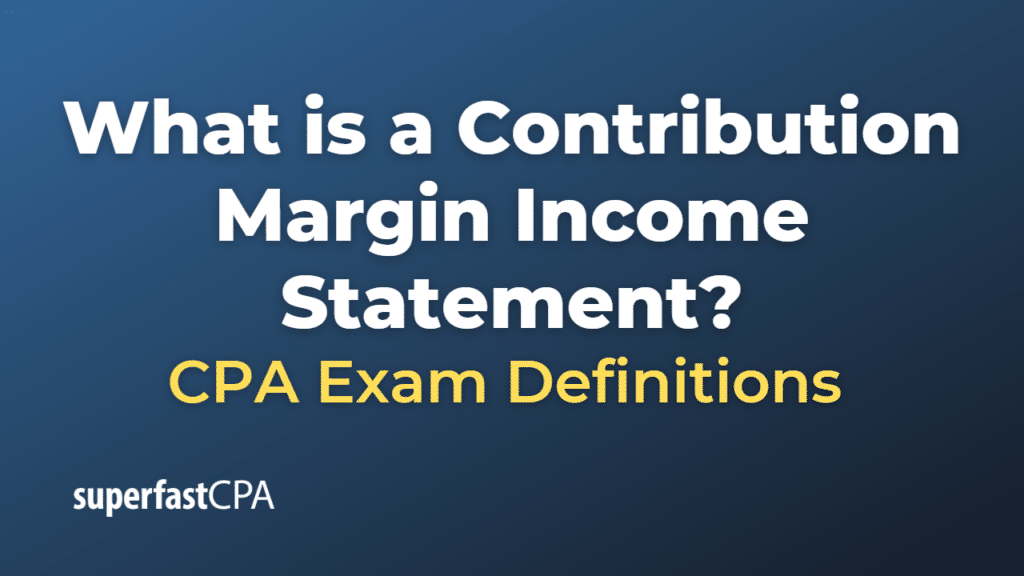Contribution Margin Income Statement
A contribution margin income statement is a financial report that focuses on a company’s contribution margin as a key performance indicator. Unlike the traditional income statement, which separates costs into categories such as cost of goods sold (COGS) and operating expenses, the contribution margin income statement organizes costs into variable and fixed categories. This approach helps businesses better understand the relationship between sales, variable costs, and fixed costs, allowing for more informed decision-making related to pricing, product mix, cost efficiency, and resource allocation.
The contribution margin income statement has the following format:
- Sales Revenue: The total revenue generated from the sale of products or services.
- Variable Costs: The costs that vary directly with the production or sales volume, such as raw materials, labor, and commissions.
- Contribution Margin: The difference between sales revenue and variable costs. This amount represents the funds available to cover fixed costs and generate a profit.
- Fixed Costs: The costs that do not change based on production or sales volume, such as rent, salaries, and insurance.
- Operating Income: The difference between the contribution margin and fixed costs, representing the company’s profit before accounting for interest and taxes.
Here’s the basic formula for a contribution margin income statement:
Operating Income = (Sales Revenue – Variable Costs) – Fixed Costs
By focusing on the contribution margin, the contribution margin income statement provides valuable insights into a company’s financial performance and efficiency. It enables businesses to assess the profitability of individual products or services, make informed pricing decisions, evaluate cost efficiency, determine optimal product mix, and guide resource allocation decisions.
Example of a Contribution Margin Income Statement
Let’s consider a hypothetical example of a company that sells two types of products: Product X and Product Y. Here is the sales and cost information for the month:
Product X:
- Selling price per unit: $100
- Units sold: 200
- Variable cost per unit: $60
Product Y:
- Selling price per unit: $150
- Units sold: 100
- Variable cost per unit: $90
The company has $10,000 in monthly fixed costs.
Now, let’s create a contribution margin income statement for this company:
- Sales Revenue:
- Product X: $100 (price) x 200 (units sold) = $20,000
- Product Y: $150 (price) x 100 (units sold) = $15,000
- Total Sales Revenue: $20,000 (Product X) + $15,000 (Product Y) = $35,000
- Variable Costs:
- Product X: $60 (variable cost) x 200 (units sold) = $12,000
- Product Y: $90 (variable cost) x 100 (units sold) = $9,000
- Total Variable Costs: $12,000 (Product X) + $9,000 (Product Y) = $21,000
- Contribution Margin:
- Total Contribution Margin: $35,000 (Sales Revenue) – $21,000 (Variable Costs) = $14,000
- Fixed Costs:
- Total Fixed Costs: $10,000
- Operating Income:
- Operating Income: $14,000 (Contribution Margin) – $10,000 (Fixed Costs) = $4,000
The contribution margin income statement for this company would look like this:
Sales Revenue: $35,000
- Variable Costs: $21,000
Contribution Margin: $14,000
- Fixed Costs: $10,000
Operating Income: $4,000
In this example, the contribution margin income statement highlights the company’s contribution margin, which is the amount available to cover fixed costs and generate a profit after accounting for variable costs. This format allows the company to analyze the profitability and financial performance of its products and make informed decisions related to pricing, product mix, cost efficiency, and resource allocation.













